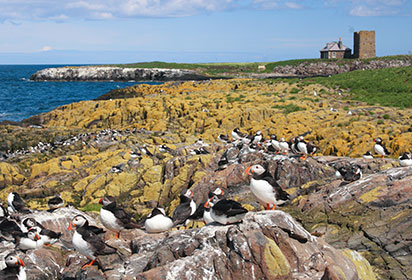Written by Gemma Hall
Classic upland bird species like ring ouzel (also known as the ‘mountain blackbird’), wheatear and whinchat inhabit the sheltered slopes of burns. Higher up, particularly where there are crags, look out for peregrine falcons and ravens (the Hen Hole in College Valley is a good place). Red grouse are frequently seen (and heard) flying out of heather, particularly in the Simonsides.
Along the fast-flowing rivers, dippers are easy to spot bobbing up and down on rocks (similar size and colour of a blackbird but with a prominent white ‘bib’). The other bobbing bird you are likely to see on the shinglebanks is the grey wagtail (slate-coloured back and yellow chest). Look out for rarer yellow wagtails as well (almost completely yellow). Breeding waders include common sandpipers, oystercatchers, redshank, lapwing and curlew – or ‘whaup’ to give it its local name.
Northumberland boasts some of the best salmon and trout rivers in England, notably the rivers Tweed, Till and Tyne. Salmon and sea trout spawn in Cheviot burns. Find a bridge in autumn from which to watch them leaping over rapids.
Good places to look out for goosanders and otters are in the lower reaches of some rivers such as the Coquet (in the Rothbury and Brinkburn Priory area, for example) and River Breamish around Ingram. Otters are famously elusive but you never know if you have the patience to sit quietly in a secluded riverside spot at dusk or early in the morning. You’re unlikely to chance upon one while out walking (they’ll be aware of your presence and move on); you’re much better off staying in one place and allowing them to come to you. Otter spraint (poo) on rocks will indicate they are around. Even if you don’t see one, plenty of other birds (kingfishers, dippers, herons) and mammals (particularly bats in wooded stretches of rivers) will no doubt make an appearance.
Goats have been a feature of the British countryside for as long as the land has been farmed. In England, our native goats almost completely died out in the 19th century when exotic breeds from overseas were introduced to the UK. However, some native breeds – escapees and the like – survived in a handful of remote corners – places like College Valley for instance. The shaggy, long-horned goats you may come across today in the Cheviots are descendants of the earliest primitive goats that were domesticated over thousands of years successively from the time of Neolithic farmers onwards.
These scarce animals are not as timid as you might imagine but still have a wariness that is to be expected of a breed that has run wild in the hills for a very long time. Occasionally walkers come across a kid that looks as if it’s been abandoned. It hasn’t of course and its mother will return soon enough.
Four herds are found in the National Park: at Kielderhead, Upper Coquetdale, and Yeavering Bell and Newton Tors near College Valley. Each herd is directed to the best grazing grounds by an old nanny who knows the hills well.
Hoping to find out more about Northumberland? Why not take a look at our comprehensive travel guide:

